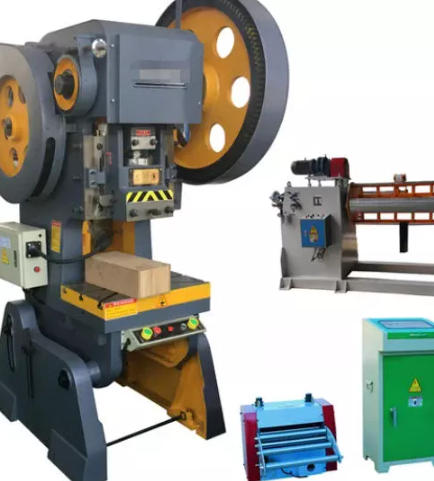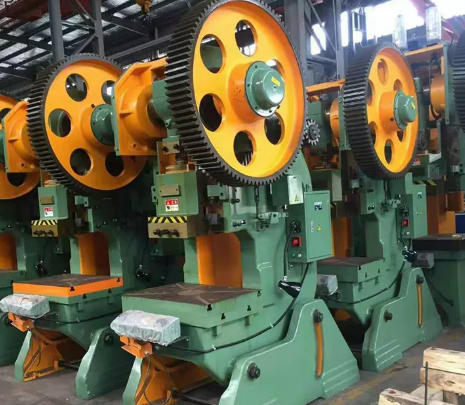Views: 222 Author: Rebecca Publish Time: 2025-11-19 Origin: Site









Content Menu
● Understanding the Role of Punch Press Machines in Tableware Production
>> How Punch Press Machines Work
>> Key Stages in Metal Tableware Production
● How Punch Press Machines Improve Tableware Quality
>> 1. Precision and Dimensional Accuracy
>> 3. Material Integrity and Strength
>> 4. Higher Efficiency and Output
>> 5. Energy and Material Savings
● Types of Punch Press Machines in Tableware Manufacturing
● Key Considerations When Selecting the Right Punch Press
>> 2. Die Compatibility and Lifespan
>> 3. Automation Compatibility
>> 5. Operator Safety and User Interface
● Integration of Punch Press Machines in Modern Manufacturing Lines
>> Data Monitoring and Predictive Maintenance
>> Integration with Quality Control Systems
● Real-World Example: Stainless-Steel Spoon Line
● Advanced Technologies Shaping Punch Press Evolution
>> AI-Assisted Control Systems
● Benefits of Investing in High-Performance Punch Press Equipment
>> Quality Assurance and Certification Support
>> Competitive Edge in the Market
● Environmental and Energy Considerations
● Future Outlook of Tableware Production
● FAQ
>> (1) What tonnage range is recommended for tableware manufacturing?
>> (2) How can CNC punch presses reduce manufacturing errors?
>> (3) What is the main advantage of servo punch presses over mechanical ones?
>> (4) How does robotic automation improve productivity?
>> (5) Are eco-friendly punching technologies available today?
In the competitive world of kitchenware and tableware manufacturing, every production line must balance precision, efficiency, and design appeal. Companies that produce stainless steel cutlery, aluminum trays, and cookware rely on specialized machinery to shape metal into functional and elegant household products. Among these machines, the punch press machine is the cornerstone of modern tableware production.
The right punch press machine determines not only how efficiently a factory can produce utensils but also the overall product quality, durability, and visual consistency. A poor machine choice can lead to uneven forming, material waste, and inconsistent results. Conversely, a properly selected punch press establishes stability, cost savings, and excellence in craftsmanship — key factors that define premium kitchenware brands.

Punch press machines are designed to perform precise metal-forming tasks. Using controlled force, they shape metal sheets into predetermined forms through die sets. These machines convert stainless steel or aluminum sheets into forks, spoons, knives, lids, and bowls used in kitchens worldwide.
The basic operation involves a ram moving vertically to press a metal sheet against a stationary die. The die cavity defines the final shape of the product. Punch presses can perform cutting, bending, drawing, and embossing operations in one or multiple steps. When paired with automated feeders and conveyors, the process becomes continuous, ensuring a high level of efficiency.
1. Blanking: Cutting flat metal sheets into blanks that roughly match the utensil shape.
2. Forming: Applying pressure to achieve a bowl-like contour or specific depression.
3. Trimming and punching: Removing excess edges or creating holes and joints.
4. Embossing: Adding brand patterns or decorative textures.
5. Polishing and finishing: Preparing parts for coating, buffing, or electroplating.
Every step influences how consumers perceive the final product's comfort, appearance, and quality.
Consistency in shape and size is vital for all categories of tableware, from cutlery to serving dishes. A CNC-controlled punch press executes each stroke with predictable accuracy. Even during 24-hour production runs, the first and last piece remain virtually identical. This precision reduces manual inspection time and ensures seamless assembly and packaging.
Advanced servo and hydraulic systems minimize friction and uneven stretching, producing tableware with smooth, reflective surfaces. The uniform finish simplifies subsequent polishing and eliminates defects such as rippling or thinning edges, which can appear on inferior equipment.
A well-suited punch press applies consistent pressure without exceeding the material's yield strength. This prevents microfractures that could degrade durability. This is crucial for kitchenware exposed to heat, washing, and mechanical wear.
Modern presses can process thousands of units per hour when integrated into automated lines. Multi-operation dies allow cutting, forming, and piercing in one pass, significantly reducing cycle time.
With precise pressure control and intelligent nesting software, machines optimize the use of metal sheets. This reduces offcuts and contributes to sustainable manufacturing — a growing priority among eco-conscious consumers and brands.
Best suited for high-speed stamping, mechanical presses are ideal for specific components such as flat serving spoons and lids.
- Advantages: Fast operation, steady performance.
- Limitations: Less control over stroke pressure.
Hydraulic systems deliver smooth force through oil pressure, suitable for deep-drawing operations required in cookware.
- Advantages: Superior control, steady pressing for varied depths.
- Limitations: Slightly lower cycle speed than mechanical setups.
This modern type uses electric servo motors to achieve variable speed and precise force adjustment.
- Advantages: High energy efficiency, easy programmability, quiet operation.
- Applications: Multi-stage forming and high-end custom tableware.
Utilizing compressed air, pneumatic presses work well for light-duty or repetitive trimming.
- Advantages: Affordable, low maintenance.
- Best for: Small accessory pieces or secondary operations.

Different metals — stainless steel, aluminum, or copper — require different tools and pressing forces. Stainless steel's resilience demands higher tonnage, while aluminum allows gentler forming due to its ductility.
The die shape determines final geometry and quality. A precise punch press ensures uniform die alignment and prolongs tool life. Investing in robust die materials like tungsten-carbide can drastically lower maintenance costs.
Many modern presses support automatic feeding and robot-assisted unloading. Integration improves output consistency and reduces manual labor. For global kitchenware factories, automation also enhances traceability and quality control.
Manufacturers generally select presses between 25 and 800 tons depending on part complexity and material thickness. For deep pots or large serving bowls, a 400–800-ton hydraulic press is typical.
Safety is non-negotiable. Machines equipped with automatic shutoff, dual-hand operation modes, and real-time load sensors protect workers and prevent accidents. Intuitive touch-screen interfaces simplify operation and error diagnostics.
Feeding coils or pre-cut sheets automatically into punch presses eliminates idle time. This system ensures proper alignment and consistent tension, improving product uniformity.
Collaborative robots (cobots) transfer formed parts from one station to another, preventing scratches and ensuring precision stacking. Automation reduces physical strain on operators and allows continuous production cycles.
Modern presses include digital monitoring modules. They record data on cycle count, temperature, and vibration. Predictive maintenance algorithms then alert technicians before any failure occurs, minimizing unplanned downtime.
Vision inspection systems mounted near the press exit check dimensions, surface defects, and edge quality automatically. This improves first-pass yield and strengthens brand reputation for quality tableware.
A kitchenware factory in Zhejiang operates a fully automated spoon production line. Sheets of 0.8 mm stainless steel pass through a servo punch press for blanking, followed by a hydraulic press for forming. The plant outputs 120,000 pieces daily, achieving more than 98% yield while reducing raw material waste by 7%.
The process integrates robotic handling and immediate trimming, streamlining production and enhancing precision. This example demonstrates how correctly chosen punch press technology elevates both output and craftsmanship.
Artificial intelligence modules automatically optimize stroke speed and tonnage for each material batch, compensating for variations in hardness or thickness. This ensures stable production with less trial-and-error setup.
Smart punch press machines communicate with central factory systems. Engineers can monitor performance remotely, track energy use, and adjust settings via digital dashboards. Data-driven factories improve overall equipment efficiency (OEE).
Hybrid servo-hydraulic mechanisms combine the swift response of electric drives with the heavy force of hydraulics. This enables efficient forming of both light and deep components on the same platform.
Manufacturers are emphasizing eco-design — such as using water-based hydraulic fluids and regenerative braking motors — to reduce carbon footprint and electrical load.
Precision control allows manufacturers to produce different product types: deep trays, flat plates, embossed covers, or utensils with embossed detail — all on the same production line.
High-quality machines reduce vibration and thermal load, extending die life by up to 50%. Longevity lowers replacement and maintenance costs.
Modern machines meet international safety and quality certifications like ISO 9001 and CE. This ensures manufactured tableware meets export standards for major markets such as Europe and North America.
Factories with efficient punch systems can produce faster, cheaper, and with greater consistency — important advantages for OEM suppliers serving global kitchenware brands.
Punch press technology strongly impacts the environmental footprint of manufacturing operations. Efficiency gained from servo and hybrid systems translates to lower carbon emissions and reduced power bills. Minimizing waste metal sheet usage is equally critical, since stainless steel production itself is energy-intensive.
Sustainability now doubles as a marketing advantage: end consumers increasingly prefer eco-friendly brands. Therefore, adopting optimized press machinery positions manufacturers for growth in the green consumer segment.
As consumer demands for design variety and sustainability rise, the kitchenware industry will rely even more on flexible and intelligent production lines.
- Mass customization will allow manufacturers to quickly adapt press settings for new utensil styles.
- Digital twins will simulate stamping performance, reducing prototype costs.
- Zero-defect manufacturing will be achieved through predictive AI inspections linked directly to each punch press cycle.
These advancements will merge efficiency with artistry, enabling global brands to produce tableware that is both affordable and beautiful.
In the tableware manufacturing industry, the right punch press machine forms the backbone of quality, efficiency, and innovation. Precision forming ensures consistent shapes and smooth finishes, while automation reduces costs and waste. By choosing technology aligned with material properties, production volume, and environmental responsibility, manufacturers unlock both profitability and sustainability.
As industry standards evolve, investing in advanced punch press systems positions producers to meet tomorrow's demands — creating cookware and utensils that exemplify durability, performance, and craftsmanship in every detail.

Typically, manufacturers use presses between 25–800 tons. Small cutlery items often need around 40–80 tons, while cookware requires more powerful hydraulic systems over 400 tons.
CNC controls ensure that each stroke maintains correct pressure and timing, minimizing human variation and enabling consistent quality even in large batches.
Servo presses provide programmable motion profiles, adjustable speed, and superior energy efficiency, ideal for complex or multi-step forming tasks.
Automation ensures continuous feeding, faster transitions between operations, and reduced downtime, allowing round-the-clock production with minimal labor involvement.
Yes. Modern machines utilize regenerative drives, energy-saving motors, and smart control systems to cut electricity consumption and reduce environmental impact.
Why The Right Punch Press Machine Is Crucial for High-Quality Tableware Production?
Punch Press Machines: The Backbone of Efficient Cutlery Production
How To Choose Between Manual And Automatic Punch Press Machines?
Best Punch Press Machines for Small And Large-Scale Manufacturers
Top Manufacturers of Punch Press Machines for The Tableware Industry
What Are The Key Benefits of Investing in A Punch Press Machine for Your Factory?
How Punch Press Machines Are Revolutionizing The Cutlery Industry?
The Role of Punch Press Machines in Modern Kitchenware Production Lines
Punch Press Machine Vs. Turret Punch Press: What's The Difference?
